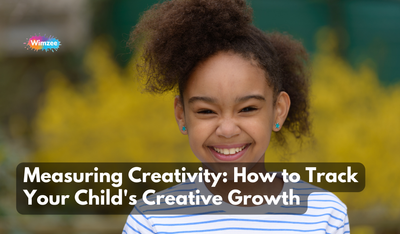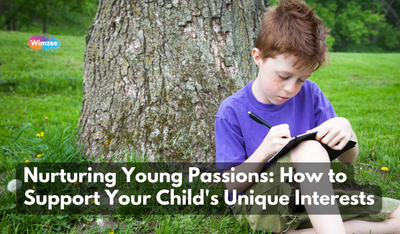Tracking your child's creative growth might seem like catching lightning in a bottle—elusive and tricky. Yet, understanding and nurturing their creativity is crucial. Creativity isn't just about making art; it's about problem-solving, thinking outside the box, and expressing ideas. This blog will help you explore practical ways to gauge and enhance your child's creative abilities, making it an exciting journey for both you and your child.
Understanding Creativity in Children
Creativity in children is a multifaceted gem, shining beyond the realms of art and crafts. It encompasses problem-solving, innovation, and the ability to see the world in unique ways. This broad definition helps us recognize that creativity is integral to overall child development.
The Broader Scope of Creativity
Creativity isn't limited to drawing or painting. It involves thinking outside the box, finding multiple solutions to a problem, and expressing ideas in innovative ways. For instance, when a child uses building blocks to create an imaginative structure or crafts a unique story, they're exercising their creative muscles. These activities foster cognitive flexibility, critical thinking, and emotional expression.
Significance in Child Development
The role of creativity in child development is profound. It nurtures cognitive growth by challenging children to think in diverse ways. Socially, it helps them express their feelings and connect with others through shared imaginative play. Emotionally, it builds resilience as they learn to approach challenges with a problem-solving mindset.
Children's creativity is also closely tied to their sense of self. When kids see their creative ideas valued, it boosts their confidence and encourages them to keep exploring and expressing themselves. This confidence can carry over into other areas of life, enhancing their academic and social skills.
Understanding these aspects of creativity highlights its importance in nurturing well-rounded, adaptable, and emotionally intelligent children. By recognizing and fostering creativity in our kids, we set the stage for their overall development and future success (Oxford Academic).
Recognizing Everyday Creativity
Creativity in kids can show up in the most unexpected places, from organizing toys in unique ways to crafting elaborate stories. Everyday activities provide ample opportunities for creativity to flourish, and recognizing these moments is key to nurturing a child's imaginative growth.
The Magic in Everyday Tasks
Simple activities like organizing toys can reveal a lot about a child's creative thinking. When kids sort their toys by color, size, or even create their own categories, they're engaging in creative problem-solving. This organizational play helps develop their ability to see patterns and think systematically while adding their personal touch.
Storytelling is another powerful outlet for creativity. When a child weaves tales with their toys, they are not just playing; they are practicing narrative skills, exploring different scenarios, and expressing their inner thoughts. Encouraging kids to tell stories, whether through play or bedtime stories, can significantly boost their imaginative skills.
How Creativity Manifests Differently
Every child is unique, and so is their creative expression. One might be a natural storyteller, creating complex narratives for their action figures, while another might prefer building intricate structures with blocks. Some children show creativity through art, drawing vivid pictures or making crafts, while others might express it through movement and dance.
Parents can support this diversity by providing a variety of materials and opportunities. Offering open-ended toys like building blocks, art supplies, and costumes for dress-up allows kids to explore different creative outlets. According to experts, fostering an environment where kids feel free to experiment without fear of making mistakes is crucial for their creative development (UConn Today).
Understanding that creativity doesn't always look the same and encouraging children to explore their interests in various ways helps them develop a rich, imaginative skill set. By recognizing and celebrating the small, everyday creative acts, we can nurture a lifelong love of creativity in our kids.
Tools and Techniques for Measuring Creativity
Measuring creativity might seem as tricky as pinning down a rainbow. Luckily, there are established tools that help in evaluating a child's creative abilities. These methods provide insights into their unique way of thinking and can guide parents and educators in nurturing their creative potential.
Torrance Test of Creative Thinking
The Torrance Test of Creative Thinking (TTCT) is one of the most well-known tools for assessing creativity. Developed by Ellis Paul Torrance in the 1960s, this test evaluates several aspects of creative thinking:
- Fluency: The number of ideas a child can produce.
- Originality: How unique those ideas are.
- Elaboration: The level of detail in the child's ideas.
- Abstractness in Titles: The ability to use metaphor and symbolism.
- Resistance to Closure: How well the child can stay open to new information and ideas without rushing to conclusions.
Consensual Assessment Technique (CAT)
The Consensual Assessment Technique (CAT) is another effective method. Unlike standardized tests, CAT involves multiple experts independently evaluating the creativity of a child's work, such as a piece of art or a story. This method relies on the consensus that something is creative if recognized as such by experts in the field. It's flexible and can be adapted to various types of creative output (Edutopia).
Observations and Simple Assessments at Home
Parents don't need formal tests to gauge their child's creativity. Simple observations and activities can reveal a lot:
- Creativity Journals: Encourage your child to keep a journal of their ideas, stories, and drawings. Review these entries together to spot patterns in their creative thinking.
- Creative Challenges: Pose open-ended challenges like "What can we do with this empty box?" or "How many uses can you think of for a paperclip?" These activities stimulate divergent thinking, which is crucial for creativity .
- Art and Play: Pay attention to how your child engages in creative play and art. Do they come up with original stories or unique ways of building with blocks? These are signs of their creative development (IntechOpen - Open Science Open Minds).
Practical Tips for Parents
- Encourage Exploration: Let your child explore different activities without fear of making mistakes. Creativity thrives in an environment where experimentation is encouraged.
- Ask Open-Ended Questions: Instead of yes/no questions, ask ones that require thought and creativity, like "What do you think would happen if...?" or "How else could we do this?"
- Provide Diverse Materials: Keep a variety of creative materials at home—art supplies, building blocks, musical instruments—to inspire your child's imagination (Advanced Psychology Services).
By using these tools and techniques, you can better understand and support your child's creative journey, making the process both fun and enlightening for both of you.
Role of Creative Play
Unstructured play, also known as free play, is like a magical ingredient in the recipe for childhood development. It’s the kind of play where kids are in charge, making up games, exploring their world, and letting their imaginations run wild. This type of play is crucial for fostering creativity, as it allows children the freedom to explore, experiment, and express themselves without the constraints of structured activities.
Importance of Unstructured Play
Unstructured play provides numerous benefits:
- Social-Emotional Growth: During free play, kids often engage in pretend play, build with blocks, or create their own games. These activities help them develop social skills like negotiation, collaboration, and conflict resolution. They learn to express emotions, experiment with social roles, and build empathy.
- Cognitive Development: When children play freely, they are constantly problem-solving, making decisions, and thinking critically. Whether they’re figuring out how to build the tallest tower or navigating a make-believe adventure, these activities enhance their cognitive skills and foster a love of learning.
- Physical Benefits: Unstructured play often involves physical activities like running, climbing, and jumping, which contribute to the development of gross motor skills. Fine motor skills are also honed through activities like drawing, building, or playing with small objects.
Encouraging Creative Play at Home
Here are some tips to promote creative play without hovering:
- Provide Open-Ended Materials: Stock up on items that can be used in various ways, like building blocks, art supplies, dress-up clothes, and recycled materials. These encourage kids to use their imagination and creativity.
- Create a Safe Play Environment: Ensure that children have a safe space to explore and play freely. This might be a dedicated playroom or a section of the backyard. The key is to provide a secure area where kids feel comfortable to let their imaginations soar.
- Limit Screen Time: Encourage kids to engage in physical and imaginative play by limiting their access to screens. This fosters a more active and creative playtime (Children's Creativity Museum).
- Be a Facilitator, Not a Director: Your role is to ensure safety and provide resources, but let the kids take the lead. Observe their play, offer encouragement, and step in only when necessary. This approach helps them feel in control and boosts their confidence in their creative abilities (CQEL).
- Incorporate Outdoor Play: Nature offers a rich environment for unstructured play. Activities like building fairy houses, exploring the backyard, or just running around can spark creativity and provide a wealth of sensory experiences (creativekidsparenting.com).
By embracing the power of unstructured play, you can help your child develop crucial life skills in a fun and engaging way. Remember, the goal is to provide opportunities for your child to explore, create, and imagine freely, nurturing their natural creativity and curiosity.
Art Projects and Creative Activities
Exploring art projects with your kids is a fantastic way to spark their imagination and encourage creative thinking. Here are some engaging and age-appropriate activities that can stimulate their creativity at home.
Fun Art Projects to Try
- Thumbprint Doodles: Transform thumbprints into adorable creatures like bugs or animals. Provide ink pads and let your kids create various thumbprint designs. They can add details with markers, turning simple prints into imaginative artworks (We Are Teachers).
- Pom-Pom Caterpillars: Using colorful pom-poms and construction paper, kids can craft cute caterpillars. This activity enhances fine motor skills and lets children experiment with different colors and textures.
- Craft Stick Airplanes: Combine popsicle sticks, clothespins, and paint to make tiny airplanes. This project encourages kids to think about design and function, fostering both creativity and engineering skills.
- Chalk Planets: Create planets using chalk pastels on black paper. This project allows kids to explore space themes and develop their artistic skills by blending colors and creating unique planetary designs.
DIY Projects for Creativity
- Nature Collages: Collect leaves, flowers, and twigs during a walk and use them to create beautiful nature collages. This activity connects kids with the outdoors and encourages them to see everyday items as art materials (Knight Foundation).
- Recycled Art: Use household items like cardboard tubes, bottle caps, and old magazines to make sculptures or collages. This not only teaches kids about recycling but also challenges them to think creatively about reusing materials (Moonpreneur).
- Sensory Art: Incorporate various textures and materials like sand, fabric, and glitter into art projects. Sensory art activities engage multiple senses, which can enhance creativity and provide a richer artistic experience.
Age-Appropriate Ideas
- Tissue Paper Flowers: For younger kids, making flowers out of tissue paper and pipe cleaners is simple and fun. They can learn about colors and patterns while practicing their fine motor skills.
- Painted Rocks: Encourage older kids to collect rocks and paint them with intricate designs or messages. This project can be a relaxing and expressive activity, perfect for honing detailed brushwork (EZPlay Jungle Gyms).
- Parent-Child Pottery Classes: Sign up for pottery classes where you and your child can create together. Working with clay helps improve hand-eye coordination and lets children express their creativity in three dimensions .
Tips for Encouraging Creative Thinking
- Diverse Materials: Keep a variety of art supplies on hand—paper, paints, markers, clay. Let kids explore freely, which encourages creativity and experimentation.
- Focus on the Process: Emphasize the journey of creating rather than the final product. This approach reduces pressure and allows children to enjoy and learn from the creative process.
- Inspiring Themes: Use fun themes or prompts to ignite imagination. Ask open-ended questions like, "What would a castle in the sky look like?" to stimulate creative thinking.
By integrating these projects and tips into your routine, you can nurture your child's creative abilities, making art a joyful and enriching part of their lives.




